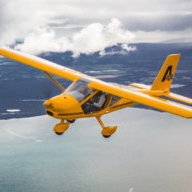-
Posts
80 -
Joined
-
Last visited
Content Type
Profiles
Forums
Gallery
Downloads
Blogs
Events
Store
Aircraft
Resources
Tutorials
Articles
Classifieds
Movies
Books
Community Map
Quizzes
Posts posted by SilverWing
-
-
SportStar crosswind
The 'demonstrated' crosswind figure for the SportStar Plus and SL/MAX (wing tanks) is 21 knots 'by an experienced factory test pilot'.
The LSA regulations require a quoted maximum crosswind figure at full flap 'capable of being achieved by a pilot of average ability'.
The SportStar factory has thus begun to quote the mixed figures 10/15/20 kts quoted by basscheffers. Hope that clears it up.
-
SL Kit
There always has been a SportStar kit - we advertised the SportStar Plus kit extensively for a while but there was so little response I stopped the adverts and concentrated on the factory built version.
The SL is available as an E-LSA 90% kit (that's an 'experimental' LSA classification, which means it can never be used for a commercial purpose like flying training). The airframe is complete - riveted and glued/bonded/corrosion proofed. The builder has to add the engine, prop, paint and instruments.
I have e-mailed the factory for a current price on the kit and I'll post it on the website under 'Pricing' as soon as I have it. Last time I had a price, it saved about Au$20,000 on the factory finished price, so you can get an estimate based on the quoted factory price.
-
SportStar MAX
The MAX is a USA-only aircraft, using wing vortex generators to keep the 600 kg 'clean' stall speed under the LSA limits. In Australia our 600 kgs stall limit is higher and in 'landing configuration' so the SportStar doesn't need the VGs to make the stall speed. The SportStar SL is thus available in Australia at 600 kgs either as a factory built or quick build kit without the VGs.
-
Oil temperature
Like many 912s I think the oil is overcooled on the SportStar - although the Rotax book says 'over 50 degrees' is OK. Personally I like mine at 80 degrees plus. I notice the new factory SportStar SL comes with an oil thermostat as standard, which (a) speeds warm-up and (b) keeps the oil over 80 degrees (and under 120 on sunny days.



EV97 - Main spar structural failure
in Evektor
Posted
EV97 Wing failure
As the Australian distributor for the SportStar, it's interesting to read the often speculative comments on this thread.
I would like to re-assure Australian (and other) SportStar owners about the safety of their aircraft in regard to this issue and refer owners and others to the Evektor factory website on Welcome to Evektor - Aircraft Producer and Design & Engineering Company.
Evektor have made it quite clear that the latest Eurostar model (the SLW) and the SportStar are NOT affected by this issue.
Lest you are thinking: "Well he would say that, wouldn't he?" here are some facts.
The SportStar is not just a 'name-change' marketing exercise, it is a different aircraft from the Eurostar, developed specifically for the (then) expected Light Sport Aircraft market proposed in 2001/2002. The SportStar was the first LSA of any type to be registered (a) by FAA in the USA (April 2005)and (b) by CASA in Australia (May 2006).
3 different versions of the SportStar are flying in the world, including Australia:
- the original 'fuselage tank' version, certified to 550 kgs MTOW
- the SportStar Plus, with wing tanks, certified at 575 kgs MTOW (which can be increased to 600 kgs without airframe modification, under a service bulletin issued by the factory)
- the SportStar SL/MAX also with wing tanks, certified at 600 kgs MTOW
The aircraft involved in the WA accident was one of the 'fuselage tank' aircraft. I cannot comment on that accident as the report has not yet been published. However, the manufacturer was involved and co-operated fully in the investigation and it is my understanding that no fault was found with either the design or construction of the airframe.
Here are the main differences between the SportStar and the Eurostar:
- the SportStar is all round a bigger aircraft
- MTOWs on SportStars are between 100 and 150 kgs higher than on the Eurostar
- empty weights are also higher, as much as 50 kgs in the latest versions (and yes, some of that has gone into the wing main spar)
- the spar design on the SportStar (all versions), particularly at the wing root, is different from the Eurostar. Apart from the higher MTOWs, other practical evidence of this is that the optional wing-fold mechanism available on the Eurostar cannot be fitted to the SportStar.
In Australia, we have some of the highest flight-time SportStars in the world - including a fuselage tank aircraft with over 3,500 hours of training and hire, and several SportStar Pluses with over 3,000 hours.
LSA aircraft like the SportStar have much higher 'G' ratings than typical GA aircraft - however, this does not mean they can be flown without consideration for load and turbulence. As one contributor mentioned, aerobatics and manouvres like high-G steep turns etc will substantially reduce the life and strength of any airframe (in the case of one well-known military trainer a reduction from 15,000 hours to 4,500 hours for frequent aeros).
I firmly believe the SportStar is as safe an aircraft as any on the market - provided you fly it within the manufacturer's limitations and do not abuse it with high-G activities.